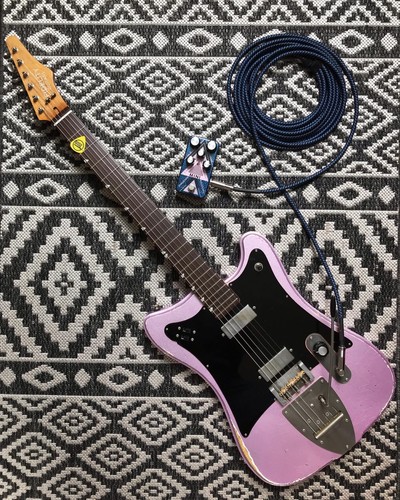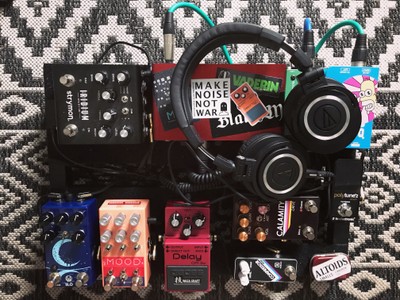Uses
This is a living document of the tools I use to create this website and record my demo loops.
Guitars
My custom Fidelity Guitars Stellarosa Lite II. This is probably the guitar I'm playing the most right now.
It records so well. It's chimey and articulate without being harsh.

Here are some details about it:
- Roasted maple neck with wenge fretboard. The neck has the most comfortable shape – I believe it's a chunky C. Very well set up out of the box. Amazing fretwork.
- Obeche body
- Descendant Vibrato
- Lollar Firebird Pickups. The best I can describe them by is something between a beefy Tele and a more articulate Humbucker. The neck is punchy and glassy, like a Strat neck pickup on steroids. The bridge is like a higher output Tele bridge, a bit more smooth and a little scooped in the mids. All without noise because they are humbuckers.
- It only has a volume knob, a 3-way pickup selector and two slide switches. One switch toggles the series mode. Both pickups are then wired in series, which results in more output and a beefier, more compressed sound. The other slide switch is a low-pass filter, meaning when it's engaged it's like turning down a tone knob to zero. I really like this on the bridge pickup for a cocked wah sound or with the series mode engaged.
- Color: Burgundy Mist Metallic nitro finish. Medium ageing on the body finish and hardware. The ageing is superb and tasteful.
My first and so far only bass is this Justin Meldal-Johnsen Road Worn Fender Mustang Bass.

The JMJ records pretty well. It has nice thumb with plenty of attack and a bump in the upper mids to stand out in a mix. I mostly use the Iridium in round mode with Ownhammer AMPG bass IRs to record bass.
I did a few mods:
- I had Baguley Guitars cut me a custom one-piece aluminum pickguard (just for looks). Knobs are also sourced by them.
- I removed the plastic pickup covers. I added heavier springs to the pickup screws. Now they don't wiggle and sit really tight, so the covers are not needed anymore. Pickup itself is the Curtis Novak Fat Mustang Pickup. The coils are wrapped in dark cotton wrap (a little customization I asked Curtis to do for me). The stock pickups were great, but these are awesome! Bass sounds meaner and growlier.
- I sanded off the back of the neck and applied some regular wood furniture finish to seal it. Feels really smooth now.
- I rounded off the fret edges. I got the bass used and due to transportation, it must have developed some fret sproud. It didn't turn out super pretty but playability-wise it's great now.
- La Bella Deep Talkin' Bass 760F-MUS Flatwound strings. Super thumpy, punchy and smooth. I think these pair really well with this bass to get that vintage short-scale vibe.
For my playing style, the JMJ is perfect for all bass recordings I need to do.
It can do the cleanish, muted Tame Impala thing. I often use the Keeley Compressor Mini with maxed out volume into the MAE Line Blur EQ/Preamp for that sound.
It's also nice for gnarly, velcro fuzz or distorted bass. I often use distortion on bass to compensate for the lack of "brilliance" you would get from roundwounds.
Accessories
Picks: Mostly orange Dunlop Tortex 0.60mm on bass, any 1mm pick I can find for guitar.
Strings: Ernie Ball 10s on guitar.
Cables: Mostly Ernie Ball for patch and instrument cables.
Pedalboard: Pedaltrain Classic Jr.
Power Supply: TrueTone 1Spot CS12.
Right now I play guitar to record demos, so my pedalboard is mostly audio interface, re-amp box, DI, Iridium, tuner, the obligatory altoids tin for picks and whatever pedals I'm currently recording with.
I have the board mainly for easy relocation purposes. I will often go downstairs to the living room to record so I don't wake up the rest of the family (even an unplugged electric can be pretty loud).
Recording
All my demos are recorded at home with a silent setup. I use the Mixwave Benson Chimera Plugin as my amp/cab sim and it's the basis for all my guitar home recordings.

From the Iridium, the signal goes straight into the Universal Audio Volt 4*. I record everything in GarageBand.
I use the XLR output and the tuner out of my Radial Engineering SB-2 StageBug to split the signal.
The XLR out goes directly to the audio interface. This is the dry and unaffected signal.
The other goes to the demoed pedal, Iridium and second input of the audio interface. I record dry and "wet" signal simultaneously.

The wet signal is just so that I have an inspiring monitor sound to record with and to "play to the pedal". Later, I delete the wet signal and only use the dry signal for reamping.
When I'm satisfied with the dry, unaffected loop, I reamp it with the Radial Engineering Pro RMP Reamp* and record the whole loop with different settings on each pedal.
For each setting you see in the demos, I recorded the whole loop with the pedal set to that setting. The loop has to be recorded for every single setting, which amounts to about 30 audio files per demo.
I also program drums, record bass and sometimes a few guitar overdubs to create a backing track for my latest demos. I mix everything so that the main guitar that goes through the pedal in the demo is in the foreground. And you can turn off the backing track to listen to finer details in sound changes through the pedal.